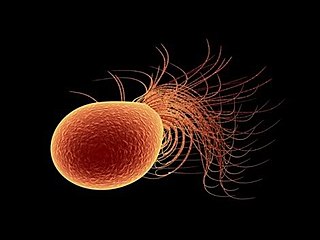
In organic chemistry, a carboxylic acid is an organic acid that contains a carboxyl group attached to an R-group. The general formula of a carboxylic acid is often written as R−COOH or R−CO2H, sometimes as R−C(O)OH with R referring to the alkyl, alkenyl, aryl, or other group. Carboxylic acids occur widely. Important examples include the amino acids and fatty acids. Deprotonation of a carboxylic acid gives a carboxylate anion.
In biochemistry, an oxidoreductase is an enzyme that catalyzes the transfer of electrons from one molecule, the reductant, also called the electron donor, to another, the oxidant, also called the electron acceptor. This group of enzymes usually utilizes NADP+ or NAD+ as cofactors. Transmembrane oxidoreductases create electron transport chains in bacteria, chloroplasts and mitochondria, including respiratory complexes I, II and III. Some others can associate with biological membranes as peripheral membrane proteins or be anchored to the membranes through a single transmembrane helix.

Pyrococcus furiosus is a heterotrophic, strictly anaerobic, extremophilic, model species of archaea. It is classified as a hyperthermophile because it thrives best under extremely high temperatures, and is notable for having an optimum growth temperature of 100 °C. P. furiosus belongs to the Pyrococcus genus, most commonly found in extreme environmental conditions of hydrothermal vents. It is one of the few prokaryotic organisms that has enzymes containing tungsten, an element rarely found in biological molecules.

Molybdopterins are a class of cofactors found in most molybdenum-containing and all tungsten-containing enzymes. Synonyms for molybdopterin are: MPT and pyranopterin-dithiolate. The nomenclature for this biomolecule can be confusing: Molybdopterin itself contains no molybdenum; rather, this is the name of the ligand that will bind the active metal. After molybdopterin is eventually complexed with molybdenum, the complete ligand is usually called molybdenum cofactor.

1-Pyrroline-5-carboxylic acid is a cyclic imino acid. Its conjugate base and anion is 1-pyrroline-5-carboxylate (P5C). In solution, P5C is in spontaneous equilibrium with glutamate-5-semialdhyde (GSA).
In enzymology, a sterol-4alpha-carboxylate 3-dehydrogenase (decarboxylating) (EC 1.1.1.170) is an enzyme that catalyzes the chemical reaction
In enzymology, a 1,6-dihydroxycyclohexa-2,4-diene-1-carboxylate dehydrogenase (EC 1.3.1.25) is an enzyme that catalyzes the chemical reaction
In enzymology, a quinoline-4-carboxylate 2-oxidoreductase (EC 1.3.99.19) is an enzyme that catalyzes the chemical reaction
In enzymology, a 2-oxo-acid reductase is an enzyme that catalyzes the chemical reaction
In enzymology, an aldehyde dehydrogenase (FAD-independent) (EC 1.2.99.7) is an enzyme that catalyzes the chemical reaction
In enzymology, an aldehyde dehydrogenase (pyrroloquinoline-quinone) (EC 1.2.99.3) is an enzyme that catalyzes the chemical reaction
In enzymology, an aryl-aldehyde dehydrogenase (NADP+) (EC 1.2.1.30) is an enzyme that catalyzes the chemical reaction
In enzymology, an aryl-aldehyde oxidase (EC 1.2.3.9) is an enzyme that catalyzes the chemical reaction
In enzymology, a glyceraldehyde-3-phosphate dehydrogenase (ferredoxin) (EC 1.2.7.6) is an enzyme that catalyzes the chemical reaction

In enzymology, a L-aminoadipate-semialdehyde dehydrogenase (EC 1.2.1.31) is an enzyme that catalyzes the chemical reaction
In enzymology, a long-chain-fatty-acyl-CoA reductase (EC 1.2.1.50) is an enzyme that catalyzes the chemical reaction
In enzymology, a 1-pyrroline-5-carboxylate dehydrogenase (EC 1.2.1.88) is an enzyme that catalyzes the chemical reaction
In enzymology, a pyrroline-2-carboxylate reductase (EC 1.5.1.1) is an enzyme that catalyzes the chemical reaction

In enzymology, a pyrroline-5-carboxylate reductase (EC 1.5.1.2) is an enzyme that catalyzes the chemical reaction

In enzymology, an aldehyde ferredoxin oxidoreductase (EC 1.2.7.5) is an enzyme that catalyzes the chemical reaction







